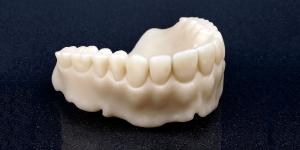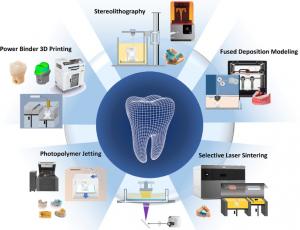Make Dental Supplies With Polyjet 3D Printing
RED CREEK, NEW YORK, UNITED STATES, September 19, 2022 /EINPresswire.com/ --
Facts About Dental 3D Printers:
The digitized dentistry industry is seeing a revolution because of 3D printing. With chair-side manufacturing of dental models and surgical guides, procedures that usually took weeks may now be completed in a matter of hours, giving local dentists complete control over patient-specific products. Fewer appointments are required, turnaround times are shorter, and costs are significantly reduced thanks to the ability to produce applications from digital files, such as night guards, temporary crowns, and dentures. This leads to an improvement in patient care overall.
Let us examine the expanding range of solutions that might usher your dental business or lab into the digital era.
Know Your Needs
Dental models for patient education and dental parts for patient usage are very different from one another, as any dentist or dental laboratory expert can attest to.
There is no need for a specialized dental printer if your objective is to print relatively accurate models of a patient’s mouth from an oral 3D scan or impression to, for example, explain a process to a patient. In fact, there are many more dental 3D printers available for making models than there are to print dental supplies parts that will come into touch with patients.
Great dental models may be printed with almost any resin printer, including many of the better filament printers.
However, you will need to use biocompatible materials certified by the regulatory authorities in your region, such as the FDA in the US, CE in the EU, KFDA in South Korea, etc., along with approved software and 3D printers if you are looking to print biocompatible dental parts, which are anything that will come in contact with a patient’s mouth or skin, e.g., clear aligners, veneers, temporary or permanent replacement teeth, or dentures. This is what this article focuses on.
Biocompatible Dental 3D Prints
Working with a 3D printer manufacturer that focuses on the dental sector (either entirely or as a large focus of their business) makes sense because there are several regulations pertaining to medical devices. These companies provide real-world knowledge, assistance, a network of dental-specific products and services, and a continuous supply of essential consumables.
Since integrating 3D printing into your dental practice or lab necessitates learning novel methods, tools, materials, and procedures, it follows that you will not benefit fully from your printer purchase without adequate training and support.
Embrace The Dental Printing Ecosystem
Digital dentistry is, of course, more than just 3D printing. Many manufacturers provide a suite of software, oral scanners, 3D printers, post-processing units, and more in a packaged approach.
Numerous 3D printer manufacturers provide dental solutions that come with service plans, including personalized onboarding, proactive check-ins, phone and email support, and resource libraries, including manuals, tutorials, and videos. A number of 3D printer producers, including SprintRay and Kulzer, are solely focused on digital dentistry. They offer a thorough strategy and guarantee seamless integration of dental printing software, printers, accessories, materials, and support.
How Are Dental Parts 3D Printed?
Here is a short rundown of the process for creating an in-office dental night guard that is customized for each patient to show how the elements of digital dentistry interact.
Starting with a digital scan of the patient’s mouth with a hand-held intraoral scanner, external scanner, or the scan of a traditional plaster dental cast or model.
Your digital images are then uploaded to CAD software made specifically for the dentistry sector, like Exocad, or the software that accompanies your 3D printer. Select the software based on your skill level and the skill level of your staff. Numerous dental CAD programs are compatible with most of the top 3D printer manufacturers.
The next step is to transfer your design files to “slicer” software, which either comes with your printer or is compatible with it if your dental software does not accomplish this automatically (most do). The slicer converts your digital model into printer-ready 3D printing instructions.
Your night guard must be cleaned to remove any residue, the supports must be removed, and it must cure in light for it to harden after being fully printed in approved biocompatible resin. It usually needs to be polished as the final stage before the patient may try it on. The complete procedure could require many hours, depending on your printer.
Criteria For Top Dental 3D Printers
What you plan to print, how much you plan to print each day or each week, how fast you need your parts, your budget, and how automated or user-friendly you want the process to be will influence the printer you choose biocompatible dental parts. Are you just getting started, expanding, or modernizing your operations?
Additionally, you should consider the manufacturer’s degree of service and support and the dental software compatible with the printers. Requesting a sample print will allow you to determine whether the print meets your requirements for details, surface finish, and strength. Most manufacturers will send you one.
Dental professionals responding to a poll by printer manufacturer Carbon ranked accuracy, reliability, maintenance, return on investment, the total cost of ownership, quality of materials, and lowest pricing as the top factors to put into consideration when choosing a 3D printer brand for their lab.
Factoring all of this together, one Dental 3D printer that stands out is the J720 Dental 3D Printer

Facts About Dental 3D Printers:
The digitized dentistry industry is seeing a revolution because of 3D printing. With chair-side manufacturing of dental models and surgical guides, procedures that usually took weeks may now be completed in a matter of hours, giving local dentists complete control over patient-specific products. Fewer appointments are required, turnaround times are shorter, and costs are significantly reduced thanks to the ability to produce applications from digital files, such as night guards, temporary crowns, and dentures. This leads to an improvement in patient care overall.
Let us examine the expanding range of solutions that might usher your dental business or lab into the digital era.
Know Your Needs
Dental models for patient education and dental parts for patient usage are very different from one another, as any dentist or dental laboratory expert can attest to.
There is no need for a specialized dental printer if your objective is to print relatively accurate models of a patient’s mouth from an oral 3D scan or impression to, for example, explain a process to a patient. In fact, there are many more dental 3D printers available for making models than there are to print dental supplies parts that will come into touch with patients.
Great dental models may be printed with almost any resin printer, including many of the better filament printers.
However, you will need to use biocompatible materials certified by the regulatory authorities in your region, such as the FDA in the US, CE in the EU, KFDA in South Korea, etc., along with approved software and 3D printers if you are looking to print biocompatible dental parts, which are anything that will come in contact with a patient’s mouth or skin, e.g., clear aligners, veneers, temporary or permanent replacement teeth, or dentures. This is what this article focuses on.
Biocompatible Dental 3D Prints
Working with a 3D printer manufacturer that focuses on the dental sector (either entirely or as a large focus of their business) makes sense because there are several regulations pertaining to medical devices. These companies provide real-world knowledge, assistance, a network of dental-specific products and services, and a continuous supply of essential consumables.
Since integrating 3D printing into your dental practice or lab necessitates learning novel methods, tools, materials, and procedures, it follows that you will not benefit fully from your printer purchase without adequate training and support.
Embrace The Dental Printing Ecosystem
Digital dentistry is, of course, more than just 3D printing. Many manufacturers provide a suite of software, oral scanners, 3D printers, post-processing units, and more in a packaged approach.
Numerous 3D printer manufacturers provide dental solutions that come with service plans, including personalized onboarding, proactive check-ins, phone and email support, and resource libraries, including manuals, tutorials, and videos. A number of 3D printer producers, including SprintRay and Kulzer, are solely focused on digital dentistry. They offer a thorough strategy and guarantee seamless integration of dental printing software, printers, accessories, materials, and support.
How Are Dental Parts 3D Printed?
Here is a short rundown of the process for creating an in-office dental night guard that is customized for each patient to show how the elements of digital dentistry interact.
Starting with a digital scan of the patient’s mouth with a hand-held intraoral scanner, external scanner, or the scan of a traditional plaster dental cast or model.
Your digital images are then uploaded to CAD software made specifically for the dentistry sector, like Exocad, or the software that accompanies your 3D printer. Select the software based on your skill level and the skill level of your staff. Numerous dental CAD programs are compatible with most of the top 3D printer manufacturers.
The next step is to transfer your design files to “slicer” software, which either comes with your printer or is compatible with it if your dental software does not accomplish this automatically (most do). The slicer converts your digital model into printer-ready 3D printing instructions.
Your night guard must be cleaned to remove any residue, the supports must be removed, and it must cure in light for it to harden after being fully printed in approved biocompatible resin. It usually needs to be polished as the final stage before the patient may try it on. The complete procedure could require many hours, depending on your printer.
Criteria For Top Dental 3D Printers
What you plan to print, how much you plan to print each day or each week, how fast you need your parts, your budget, and how automated or user-friendly you want the process to be will influence the printer you choose biocompatible dental parts. Are you just getting started, expanding, or modernizing your operations?
Additionally, you should consider the manufacturer’s degree of service and support and the dental software compatible with the printers. Requesting a sample print will allow you to determine whether the print meets your requirements for details, surface finish, and strength. Most manufacturers will send you one.
Dental professionals responding to a poll by printer manufacturer Carbon ranked accuracy, reliability, maintenance, return on investment, the total cost of ownership, quality of materials, and lowest pricing as the top factors to put into consideration when choosing a 3D printer brand for their lab.
Factoring all of this together, one Dental 3D printer that stands out is the J720 Dental 3D Printer
Michael Scott
3D Printing Ratings
+1 315-398-3036
email us here
Visit us on social media:
Facebook
Other



